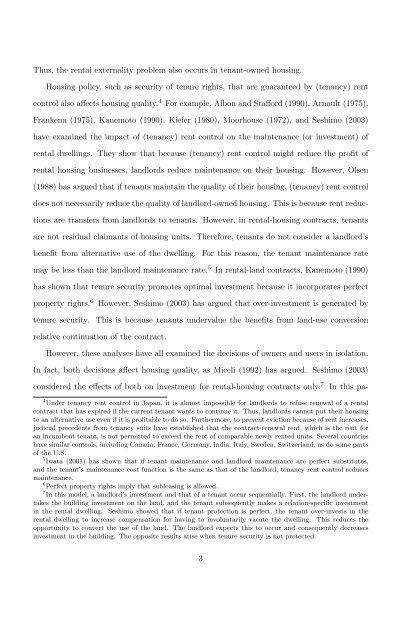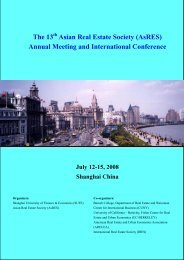Create successful ePaper yourself
Turn your PDF publications into a flip-book with our unique Google optimized e-Paper software.
Thus, the rental externality problem also occurs in tenant-owned housing.<br />
Housing policy, such as security of tenure rights, that are guaranteed by (tenancy) rent<br />
control also affects housing quality. 4 For example, Albon and Stafford (1990), Arnault (1975),<br />
Frankena (1975), Kanemoto (1990), Kiefer (1980), Moorhouse (1972), and Seshimo (2003)<br />
have examined the impact of (tenancy) rent control on the maintenance (or investment) of<br />
rental dwellings. They show that because (tenancy) rent control might reduce the profit of<br />
rental housing businesses, landlords reduce maintenance on their housing. However, Olsen<br />
(1988) has argued that if tenants maintain the quality of their housing, (tenancy) rent control<br />
does not necessarily reduce the quality of landlord-owned housing. This is because rent reduc-<br />
tions are transfers from landlords to tenants. However, in rental-housing contracts, tenants<br />
are not residual claimants of housing units. Therefore, tenants do not consider a landlord’s<br />
benefit from alternative use of the dwelling. For this reason, the tenant maintenance rate<br />
may be less than the landlord maintenance rate. 5 In rental-land contracts, Kanemoto (1990)<br />
has shown that tenure security promotes optimal investment because it incorporates perfect<br />
property rights. 6 However, Seshimo (2003) has argued that over-investment is generated by<br />
tenure security. This is because tenants undervalue the benefits from land-use conversion<br />
relative continuation of the contract.<br />
However, these analyses have all examined the decisions of owners and users in isolation.<br />
In fact, both decisions affect housing quality, as Miceli (1992) has argued. Seshimo (2003)<br />
considered the effects of both on investment for rental-housing contracts only. 7 In this pa-<br />
4 Under tenancy rent control in Japan, it is almost impossible for landlords to refuse renewal of a rental<br />
contract that has expired if the current tenant wants to continue it. Thus, landlords cannot put their housing<br />
to an alternative use even if it is profitable to do so. Furthermore, to prevent eviction because of rent increases,<br />
judicial precedents from tenancy suits have established that the contract-renewal rent, which is the rent for<br />
an incumbent tenant, is not permitted to exceed the rent of comparable newly rented units. Several countries<br />
have similar controls, including Canada, France, Germany, India, Italy, Sweden, Switzerland, as do some parts<br />
of the U.S.<br />
5 Iwata (2001) has shown that if tenant maintenance and landlord maintenance are perfect substitutes,<br />
and the tenant’s maintenance cost function is the same as that of the landlord, tenancy rent control reduces<br />
maintenance.<br />
6 Perfect property rights imply that subleasing is allowed.<br />
7 In this model, a landlord’s investment and that of a tenant occur sequentially. First, the landlord undertakes<br />
the building investment on the land, and the tenant subsequently makes a relation-specific investment<br />
in the rental dwelling. Seshimo showed that if tenant protection is perfect, the tenant over-invests in the<br />
rental dwelling to increase compensation for having to involuntarily vacate the dwelling. This reduces the<br />
opportunity to convert the use of the land. The landlord expects this to occur and consequently decreases<br />
investment in the building. The opposite results arise when tenure security is not protected.<br />
3



